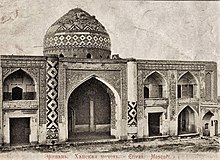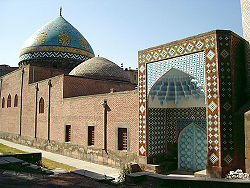List of mosques in Armenia: Difference between revisions
Too much clutter, removing some images which do not directly pertain to the topic and fixing format of sources |
|||
| Line 27: | Line 27: | ||
== See also == |
== See also == |
||
* [[Islam in Armenia]] |
* [[Islam in Armenia]] |
||
==External links== |
|||
*[http://www.beautifulmosque.com/?s=Armenia Directory of Mosques in Armenia] |
|||
== References == |
== References == |
||
Revision as of 17:03, 2 February 2014

The following is a list of mosques found within the territory of the modern Republic of Armenia.
History

According to the Caucasus Calendar of 1870, a statistical report published by the Russian Viceroyalty of the Caucasus, there were a total of 269 Shia mosques in the territory of Erivan Governorate, most of which now comprises the Republic of Armenia.[1] According to Brockhaus and Efron Encyclopedic Dictionary, by the turn of the twentieth century, the population of Erivan was over 29,000; of this number 49% were Azerbaijani Tatars; 48% were Armenians; and 2% were Russians, and there were seven Shia mosques in the town.[2]
After 1917, many of the city's religious buildings were demolished in accordance with the Soviet government's modernization and anti-religious policies.[3] In 1990, a mosque in Yerevan was pulled down with a bulldozer.[4][5] During 1988-1994 the overwhelming majority of the Muslim population, consisting of Azeris and Muslim Kurds, fled the country as a result of the Nagorno-Karabakh War and the ongoing conflict between Armenia and Azerbaijan.
In Yerevan

After the capture of Yerevan by Russians as result of the Russo-Persian War, the main mosque in the fortress, built by Turks in 1582, was converted to an Orthodox church under the orders of the Russian commander, General Ivan Paskevich. The church was sanctified on December 6, 1827 and named the Church of the Intercession of the Holy Mother of God.[6]
According to Ivan Chopin, there were eight mosques in Yerevan in the middle of the nineteenth century:
- Abbas Mirza Mosque (in the fortress)
- Mohammad Khan Mosque (in the fortress)
- Zali Khan Mosque
- Novruz Ali Beg Mosque
- Sartip Khan Mosque
- Hussein Ali Khan Mosque (Blue Mosque)
- Hajji Imam Vardi Mosque
- Hajji Jafar Beg Mosque (Hajji Nasrollah Beg)[7][8]
Of those mosques, the Blue Mosque is the only one that survives. According to 1869 data, there were a total of 60 mosques in Erivan uyezd of Erivan Governorate.[9]
See also
External links
References
- ^ Кавказский календарь на 1870 год. Тифлис, типография Главного Управления Наместника Кавказского. 1869. p. 392.
- ^ Template:Ru icon Erivan in the Brockhaus and Efron Encyclopedic Dictionary, St. Petersburg, Russia, 1890-1907.
- ^ Ritter, Markus. "The Lost Mosque(s) in the Citadel of Qajar Yerevan: Architecture and Identity, Iranian and Local Traditions in the Early 19th Century," Iran and the Caucasus 13 (2009): p. 244.
- ^ Robert Cullen, A Reporter at Large, “Roots,” The New Yorker, April 15, 1991, p. 55
- ^ De Waal, Thomas. Black garden: Armenia and Azerbaijan through Peace and War. New York: New York University Press, 2003, p. 79.
- ^ Potto, Vasiliy Aleksandrovich (2000). Кавказская война. Том 3. Персидская война 1826-1828 гг. MintRight Inc. p. 359. ISBN 5425080999.
- ^ Chopin, Jean-Marie (1852). Исторический памятник состояния Армянской области в эпоху ея присоединения к Российской Империи. Императорская Академия Наук. p. 468.
- ^ Bournoutian, George A. (1992). The Khanate of Erevan under Qajar rule, 1795-1828. Mazda Publishers. p. 173. ISBN 0939214180.
- ^ Template:Ru icon Voronov, N. I. (1869). Сборник статистических свѣдѣній о Кавказѣ. Т.1. Императорское русское географическое общество. Кавказскій отдѣл. p. 71.
